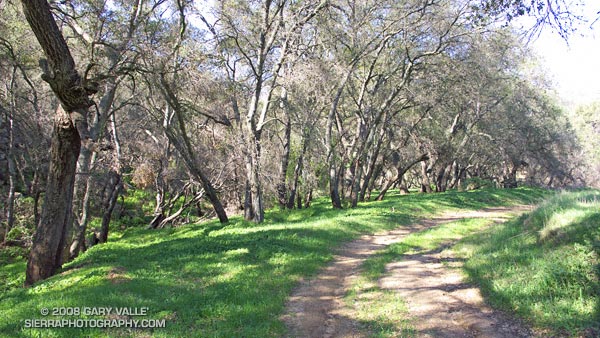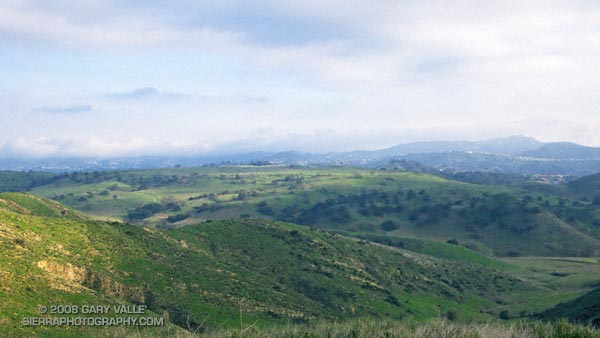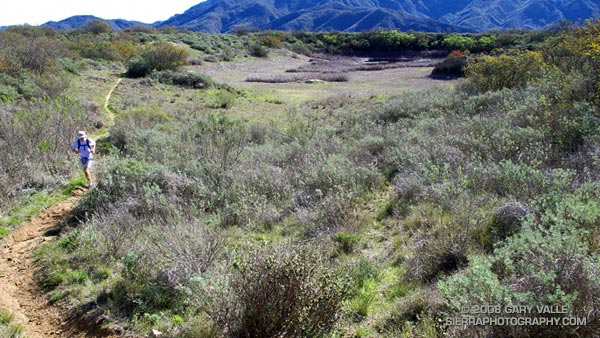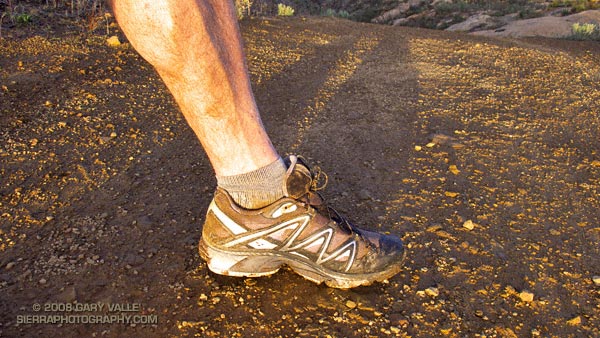
Last updated 07/05/10. Symmetrical lacing and new eyelets working great on XT Wings 2!
Wow — what a great ride! That was my impression the first time I used the Salomon XT Wings trail running shoes. That continues to be my feeling after using the shoe for a couple of weeks and doing several runs in the 15-20 mile range. For my particular trail running requirements, this shoe has a near perfect balance of comfort, smooth ride, cushioning, traction and support.
It’s been my experience that if a running shoe doesn’t feel comfortable when you first try it on, it’s not going to feel any better on a long trail run, and it’s probably going to feel worse. The XT Wings felt great from the start. I first tried a pair of 9.5’s — my usual trail shoe size — but found size 9.0 was better in this shoe.
Under foot, the shock adsorption and cushioning gave that “ahh..” feeling without feeling bouncy or unstable. The shoe provides just the right level of support, without overly restricting the motion of my foot. When combined with the super smooth foot strike to toe transition, the overall ride is the best of any trail shoe I’ve used.
The outsole rubber appears to have excellent friction, and the lug pattern seems to have good traction without being too grabby. The speed-lacing system is convenient and appears to work well. Some friends have had Salomon speed-laces prematurely fray at the first eyelet on their XA Comp 2 XCRs, and prevent that by using a little duct tape around the lace. I’ll see if that happens with this model.
Update 07/05/10. I now have about 190 miles on each of three pairs of Salomons with the the new eyelets (XT Wings, XT Wings 2 & XT Hawk 2), and I’ve had no problems with the laces fraying.
Update 02/22/10. In addition to new eyelets, the XT Wings 2 also uses symmetrical lacing. This should completely resolve the old lace-fraying issue.
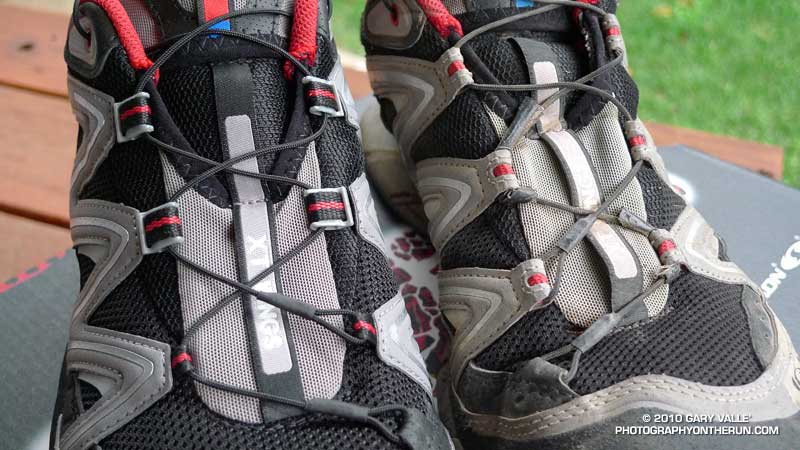
Update 01/22/10. Recently retired my fifth pair of XT Wings, again at about 300 miles. When I purchased my sixth pair was surprised to discover that the eyelet system has been redesigned. Hopefully this will resolve the problem I’ve had with the laces fraying, and I won’t have to use the “duct tape fix” on future pairs. Here’s a photo comparing the new lacing system (left) to the old one, and a close up of the new eyelet.
Update 08/05/09. Recently retired my third pair of XT Wings, at about 300 miles, and purchased my fifth pair. It’s still my shoe of choice for long runs.
Update 05/29/09. With the “duct tape fix” applied, I’m now 244 miles into my third pair of XT Wings, and 95 miles into my fourth pair — no problems. My Speedcomps, which don’t have the “toe anchored” lace like the XT Wings, have 235 miles on them, and no duct tape on the laces!
Update 09/24/08. Not good — with only 135-150 miles on my second pair of XT Wings, the lace has frayed on the left shoe at the same point (second eyelet from the anchor eyelet) as it did on the right shoe of the first pair. I’ve exchanged the pair and applied the “duct tape fix” at the second eyelets. We’ll see how it goes. Shouldn’t have to do this with a $120 pair of shoes.
Update 09/12/08. The Salomon XT Wings continues to be my shoe of choice for demanding trail runs. They are what I was in for the New Army Pass – Cottonwood Pass Loop in the Sierra, the Falls Creek Loop on San Gorgonio Mountain, the Islip Saddle – Mt. Baden-Powell South Fork Loop and Mt. Disappointment 50K in the San Gabriel Mountains, and several other long mountain runs.
Update 06/21/08. With about 250-275 miles on the pair, the lace on my right shoe broke on Thursday while running the Chumash Trail. I tied off the broken end, tightened the lace and continued the run — no big deal. In my case the lace broke at the middle eyelet on the left side of the tongue. While I hope Salomon will make the laces bombproof, the lace breaking won’t keep me from running in this outstanding shoe. I primarily use the XT Wings for longer runs.
Update 03/21/08. I’ve done several longer (20-29 mile) trail runs the last month and the shoe has performed exceptionally. I’ve had no problems with the laces or anything else. It sure seems that the smooth ride of this shoe translates to my legs feeling better at the end of a long run!
There are a couple of things I have to gripe about. At 27.7 oz, the size 9 pair I purchased is a little heavier than my Vitesses. The shoe is also expensive — $120 compared to around $85 for the Vitesse.
Related post: Salomon XT Wings 2 Trail Running Shoe
Google search: $g(Salomon XT Wings), $g(trail running)



